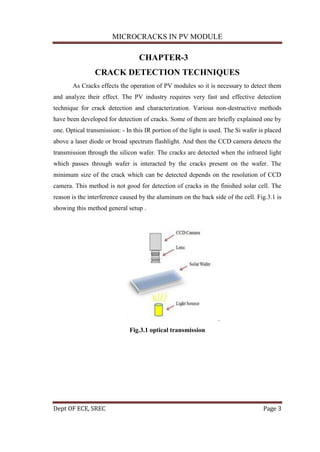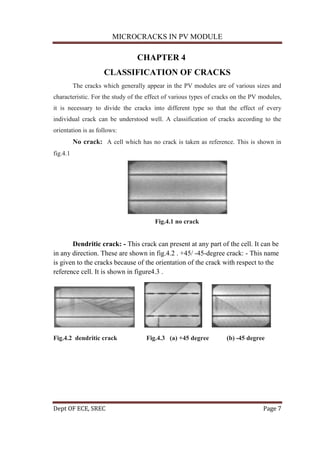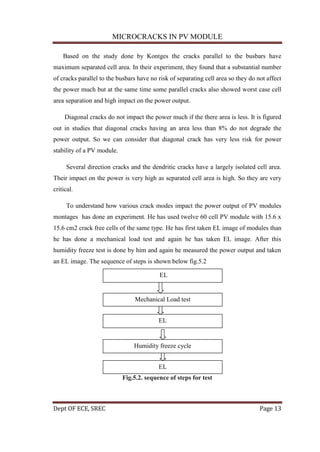Microcracks in solar photovoltaic modules can develop during manufacturing, transportation, or installation and can cause long-term power loss over the lifetime of the module. Small cracks may lead to inactive areas that are electrically disconnected within cells. It is difficult to quantify the exact impact of cracks due to varying environmental conditions modules experience. Various non-destructive techniques like electroluminescence imaging, photoluminescence, and ultrasound lock-in thermography can be used to detect cracks. Cracks are classified based on their orientation, such as +45/-45 degree cracks or cracks parallel to bus bars, to study their individual effects.



















![MICROCRACKS IN PV MODULE
Dept OF ECE, SREC Page 20
CHAPTER 8
REFERENCES
[1] S. Chattopadhyay, R. Dubey, Vivek K., J. John, C. S. Solanki, Anil K., B. M.
Arora, K. L. Narasimhan, V. Kober, J. Vasi, A. Kumar and O. S. Sastry, All India
survey of PV Module Degradation:2014
[2] Köntges M, Kunze I, Kajari-Schröder S, Breitenmoser X, Bjørneklett B
(2011) The risk of power loss in crystalline silicon-based photovoltaic modules
due to micro-cracks. Sol Energy Mater Sol Cells 95(4):1131–1137.
[3] M. Abdelhamid, R. Singh and M. Omar, "Review of Microcrack Detection
Techniques for Silicon Solar Cells," in IEEE Journal of Photovoltaics, vol. 4, no.
1, pp. 514-524, Jan. 2014.
[4] M. Kšntges, S. Kajari-Schršder, I. Kunze, U. Jahn, “Crack Statistic of
Crystalline Silicon Photovoltaic Modules”, Proc. of 26th EU PVSEC (WIP,
Hamburg, Germany, 2011) 4EO.3.6.
[5] S. Kajari-Schröder, I. Kunze, M. Kontos, Criticality of cracks in PV Modules,
Energy Procedia, 27(2012) pp.658-663.
[6] V. Gade, N. Shiradkar, M. Paggi, and J. Opalewski, "Predicting the long-term
power loss from cell cracks in PV modules," 2015 IEEE 42nd Photovoltaic
Specialist Conference (PVSC), New Orleans, LA, 2015, pp. 1-6, doi:
10.1109/PVSC.2015.7355665
[7] S. Kajari-Schröder, I. Kunze, U. Eisner and M. Köntges, "Spatial and
directional distribution of cracks in silicon PV modules after uniform mechanical
loads," 2011 37th IEEE Photovoltaic Specialists Conference, Seattle, WA, 2011,
pp. 000833-000837.
[8]. S. Spataru, P. Hacke, D. Sera, S. Glick, T. Kerekes and R. Teodorescu,
"Quantifying solar cell cracks in photovoltaic modules by electroluminescence
imaging," 2015 IEEE 42nd Photovoltaic Specialist Conference (PVSC), New
Orleans, LA, 2015, pp. 1-6.](https://image.slidesharecdn.com/microcrackchapter-170110020215/85/Microcrack-chapter-20-320.jpg)